This blog post outlines email marketing best practices that give 100% results for your campaign.
An Email marketing campaign is one of the most effective ways to reach your customers. But if you have no idea what you are doing, it will be a waste of your time & money.
An effective email marketing campaign has the potential to drive more sales, generate more revenue and boost your brand reputation. However, Email marketing can be one of the most challenging channels to master.
Since so many marketers send emails often, how can you be sure yours stands out? With the right email marketing strategy and email marketing tools, your email marketing campaigns can deliver results that surpass your competitors.
However, sending emails can be difficult if you do not know what works and what doesn’t. That’s why it’s important to adopt a set of best practices for your email marketing campaign.
In this article, we will share some email marketing best practices that will help you increase your open rate and click-through rates. These tips will help you turn your automated campaigns into an effective channel that generates results.
Email Marketing best practices you should try today:
1.Come up with a solid email marketing plan.
Anything you do without a proper plan will not give you desired results. Before sending emails to your email list, you need a solid email marketing plan.
Let’s see how you can come up with a proper plan.
The key to creating an effective email marketing plan is defining goals for each campaign & tracking them throughout the process.
Focus on the following things when creating an email marketing plan.
a). Know your audience well-
You need a clear idea of who you target and why. It will help you determine what kind of content to create for each campaign & the type of language that resonates best with your audience.
Avoid sending out emails that are too long or complex because they will end up in spam folders before people see them. Keep it short and sweet by sticking to one topic per email instead of cramming in multiple things at once.
b). Decide your goals-
Have a clear idea of what you want to achieve with your email campaigns. It will help you determine the time & effort you should put into them. And you can decide whether it is worth spending time on the email campaign.
c). Set a schedule for your campaign-
Set a schedule for when you want to send your emails and stick to it. It can be as simple as sending one email per week or once a month, depending on how many subscribers you have and how much time you want to put into them.
d). Create a list of subscribers for your campaign-
Create a list of subscribers, email templates & content ideas for sending out emails in the future. Create a list of subscribers using an email marketing service or collecting emails through social media and other sources.
e). Set up analytics-
Set up analytics to track the effectiveness of your emails in achieving these objectives. It will help to identify the faults & mistakes & help you to improve your next campaign.
2.Follow Spam acts in your country.
(a).In USA
In the USA there is a Spam act called CAN-SPAM. The CAN-SPAM Act is a United States law that regulates promotional email messages.
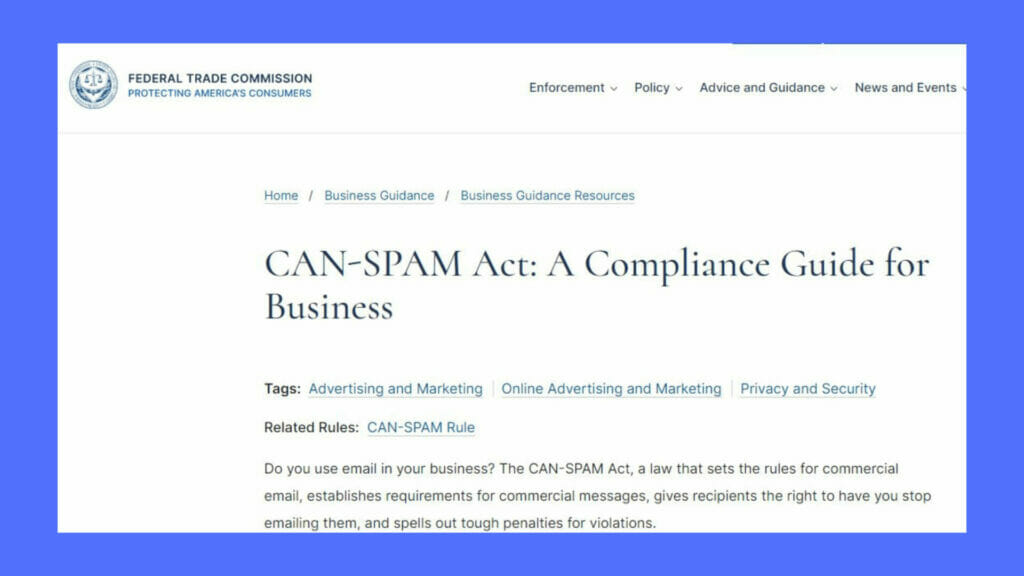
Did You Know?
CAN-SPAM stands for Controlling the Assault of Non-Solicited Pornography And Marketing. The primary purpose is to protect consumers from unsolicited email messages while setting criteria for corporations to follow while running email marketing campaigns.
Here is a breakdown of the main components of this law:
1.Consent- Before sending commercial emails, businesses must get the recipient’s permission. It is essential to give a clear and simple method for receivers to choose to receive or refuse to receive emails.
2.Identification- Commercial emails need to identify the sender. That includes having an accurate physical address in the email, usually at the end. Use legitimate contact information and refrain from using fraudulent or false headers, subject lines, or “From” identities.
3.Unsubscribe- Every promotional email from a company should have a prominent unsubscribe link. The unsubscribe button or link should be simple to find and functioning so that recipients can choose not to receive more emails from the sender in the future.
4.Content- The CAN-SPAM Act prohibits deceptive or misleading content in commercial emails. So businesses should not use deceptive or misleading headers, subject lines, or content in emails.
5.Liability- Businesses that break the CAN-SPAM Act may be subject to fines and legal action. Federal Trade Commission (FTC) may issue fines for each email violation that total up to $43,280 (as of 2021).
(b).In Australia
The Spam Act 2003 is the Australian law that governs commercial email messages. The Spam Act seeks to minimize the number of unwanted commercial messages (email, SMS, and instant messaging) sent to Australian customers.
Businesses based in Australia or sending emails to Australian customers must be aware of and in compliance with the Spam Act’s provisions. Building trust with receivers and staying in compliance with Australian laws are both facilitated by making sure your email marketing strategies are legal.
3.Send mobile-friendly emails.
Majority of the email recipients read their emails using their smartphones or other mobile devices. So, it is necessary to optimize your emails for mobile devices.
Here are some best practices to ensure your emails are mobile-friendly,
- Use responsive email templates that automatically change the layout and formatting based on the screen size and orientation of the device.
- Due to the smaller size of mobile screens compared to desktop screens, it’s critical to maintain a minimalist and clutter-free email design.
- Avoid using a lot of text, pictures, or columns that could be difficult to see on smaller devices.
- Make the content easier to read and understand by breaking it up using short paragraphs, bullet points, and headings.
- Reduce the file sizes of your photographs without reducing quality to make them more suitable for mobile devices.
These best practices help you provide your mobile recipients with a flawless and user-friendly email experience, resulting in better engagement, click-through rates, and sales.
4.Use double opt-in email sign-up.
A double opt-in email sign-up process requires an extra step to authenticate a subscriber’s email address and permission. It ensures that the person signing up truly wants to receive emails from your company, which improves the quality of your subscriber list.
Here’s how the double opt-in process typically works:
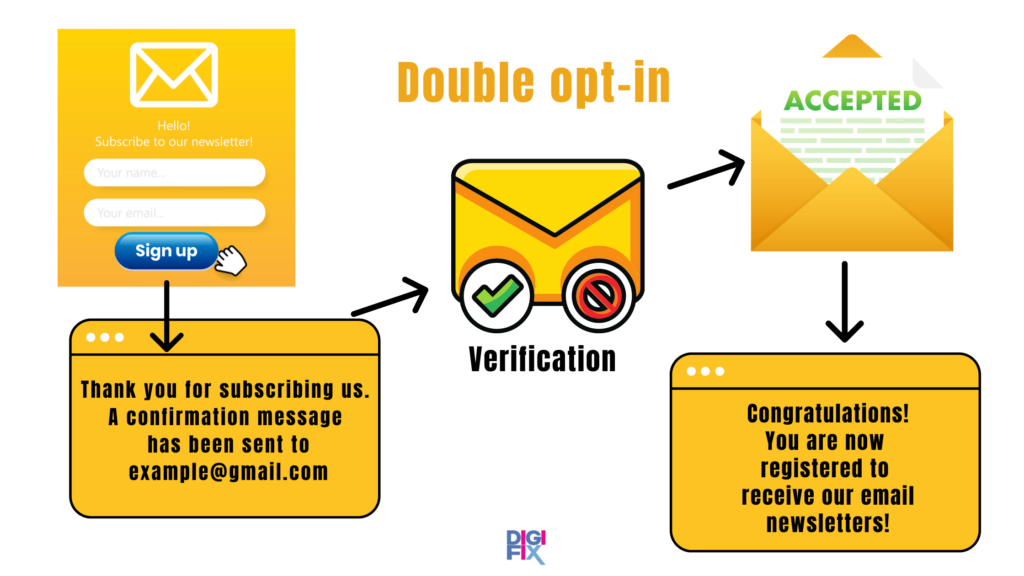
1.Initial sign-up: When someone shows a desire to join your email list, they submit their email address using a sign-up form on your website, a landing page, or other channels.
2.Confirmation email: A confirmation email is automatically sent to the specified email address following the initial sign-up. This email has a link or confirmation code for verification.
3.Subscriber confirmation: The recipient must open the confirmation email, click the verification link, or input the verification code on a confirmation page in order to finish the subscription process. Both their permission and email address are verified by doing this.
4.Thank-you page: After completing the confirmation step, users are taken to a thank-you page that acknowledges their successful subscription and might also offer extra details or the next steps.
Benefits of double opt-in email sign-up:
- Double opt-in makes sure that recipients have voluntarily declared that they want to receive emails. It enhances the engagement of your subscriber list by lowering the possibility of sending emails to unresponsive.
- Due to their active confirmation of interest, subscribers are less likely to label your emails as spam.
- You can be sure that the email addresses in your list are accurate and belong to the intended recipients if you use double opt-in.
- Double opt-in is regarded as a best practice for email marketing and shows compliance with rules and legislation like the CAN-SPAM Act.
5.Send a welcome email for a good 1st impression.
Sending a welcome email is an essential best practice in email marketing that aims to make a positive first impression and build a connection with new subscribers.
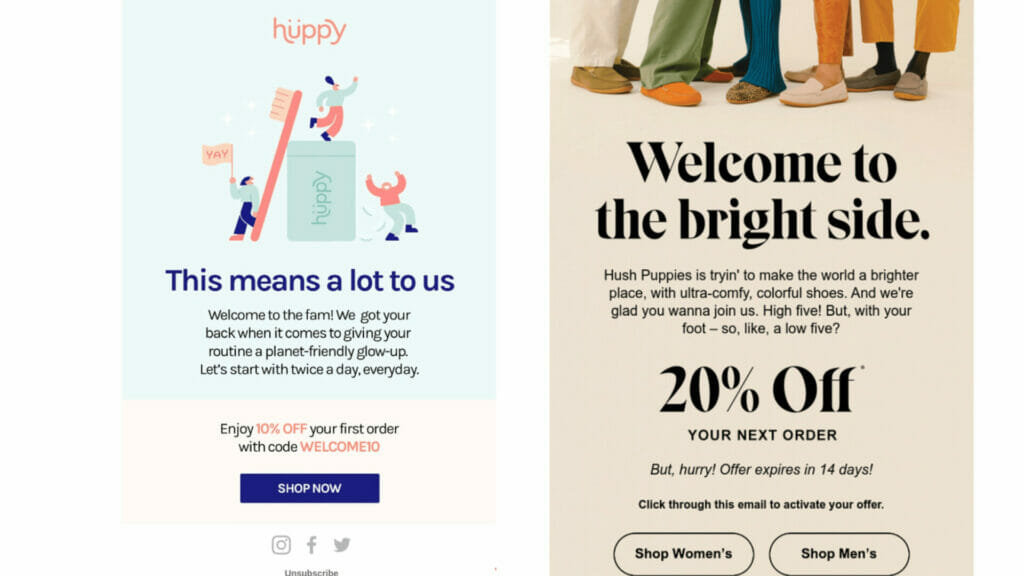
What should a welcome email consist of?
Introduction and gratitude: Thank the subscriber for joining your email list at the beginning of your welcome email. Give them a warm welcome and let them know you appreciate their interest.
Brand introduction: Use the chance to introduce your brand and supply a brief overview of what your organization does, what you offer, and the value you provide to subscribers. It helps new subscribers identify your brand identity and sets the tone for future communications.
Set expectations: Inform subscribers about what to expect from joining your email list. Let them know what kind of content they can expect from you, how often they can expect to hear from you, and what they stand to gain.
Personalization: If you have collected additional information during the sign-up process, such as the subscriber’s name or preferences, use it to personalize the welcome email. Addressing the subscriber by name adds a personal touch and helps build a connection.
Offer a welcome gift or incentive: To make the welcome email even more enticing, consider offering a special welcome gift, exclusive content, or a discount code as a token of appreciation.
Call-to-action (CTA): Include a clear and compelling call-to-action in your welcome email. It could be to explore your website, follow your social media accounts, or take advantage of a limited-time offer.
Contact information and support: Provide contact details such as customer support email or phone number, social media handles, or a link to your support center.
Unsubscribe option: While it may seem counterintuitive, including an unsubscribe option in your welcome email is important for compliance and transparency.
6.Write casually and conversationally
Writing casually and conversationally involves using a more relaxed and informal tone in your emails.
Here are some tips for a casual and conversational email:
Use everyday language: Instead of complicated or formal wording, use words and phrases used in daily conversations. It helps create a friendly and approachable tone.
Use contractions: Use contractions (e.g., “can’t,” “don’t,” “won’t”) to make your writing sound more conversational. Contractions mimic how we naturally speak and add a sense of informality to the text.
Address the reader directly: Write as if you are having a one-on-one conversation with the reader. Address them directly using pronouns like “you” and “your” to create a personal connection.
Keep sentences and paragraphs short: Long, complex sentences can make your writing feel more formal and challenging to read.
Embrace humor (when appropriate): Feel free to use light humor if the situation permits. By encouraging a conversational tone, humor can make the content more interesting and delightful.
In general, writing conversationally and casually contributes to the development of a warm, engaging, and inviting tone that connects with people and makes your content more approachable.
7.Keep Your Email Content Short and Simple.
A common mistake that many marketers make is to include too much information in their emails. After all, you want to give your subscribers as much value as possible, right?
But this doesn’t mean you should go overboard with your content; instead, try to keep things short and simple by packing only the most necessary info.
Your audience is busy and doesn’t want to spend much time reading emails. You don’t want them to scroll through your newsletter and see paragraphs upon paragraphs of text; instead, make sure you keep things short and sweet.
You can keep your content short and simple by using:
- Short sentences- Keep your sentences short and sweet. You don’t want to overwhelm your readers with long, drawn-out sentences that take forever to read. Instead, keep things brief and simple by keeping your sentences brief and precise.
- Short paragraphs- You don’t have to write an essay in your newsletter. Instead, keep things short and sweet by keeping paragraphs brief and precise. You can do this by breaking up long paragraphs into smaller ones or by using subheadings to break up the content even further. Short sentences, short paragraphs- Keep it simple!
- Bullet points (use them liberally)- Bullet points are your best friend when writing newsletters. They make your content easier to read and digest. Plus, they break up the text so that it doesn’t look like a giant block of text on the page. Use lots of them!
- Images or videos to break up text-You can also use bold or colored fonts for emphasis, but be sure not to overdo it! Emojis work well when used correctly too.
- Use the “You” form: Instead of “We do this,” say “You can do this.” It makes your content much more personal and engaging.
8.Design Responsive Emails
As a marketer, it’s important to make sure your emails are fully responsive. That means the email content will look great on any device (phone, tablet, or desktop).
For example, when designing emails for mobile devices, you need to consider their smaller screens and buttons since users will be interacting with them differently than browsing websites from their computers or tablets.
The best way to test your email designs across all devices is by using services like Litmus which allows you to send an email through their servers and see how it looks in different formats.
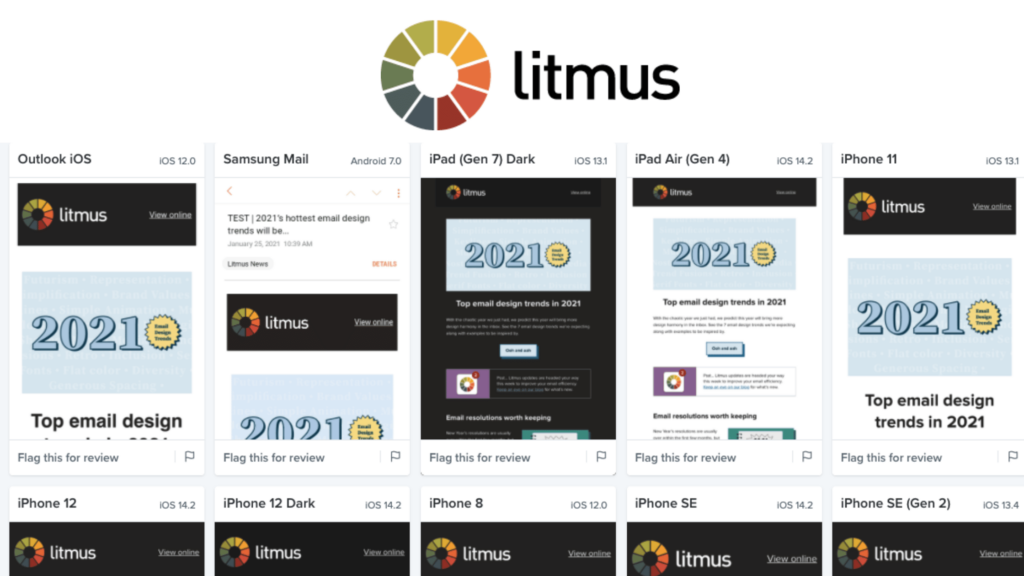
It’s also important to remember that, unlike websites, emails don’t have a lot of space for content.
So, keep your messages as concise as possible. It means using short sentences and paragraphs, avoiding links that go offsite (unless necessary), and making sure there is enough white space between elements. So it doesn’t feel too cramped for users.
9.Use Actionable Subject Lines.
Email subject lines are the first thing people see when they open their inboxes. If your subject line is boring, you can bet that it will get deleted (or worse: ignored).
You need to get the attention of your readers and make them want to open your email for it to be successful. This means crafting subject lines that are relevant and actionable so users will see them as an opportunity rather than a nuisance.
- Keep subject lines short and to the point.- If you have a long subject line, consider breaking it up into two separate messages or using a teaser to entice users further into the email. Include a call to action in the subject line- The more specific you can be about what you want users to do, the better. For example, if your offer is related to a webinar, include “register now” or “webinar registration link” in your subject line.
- Use Personalized Subject Lines- Personalizing your subject lines to speak directly to each user is one of the best ways to capture their attention and make them want to open up your email. You can do this by using data from your database or by inserting the recipient’s name in the subject line itself (e.g., “Hi Peter!”).
- Use relevant tailoring to a specific audience, and never mislead with your subject line. For example, “You’re Invited” doesn’t mean that you’re inviting people somewhere; but if you sent an email with “You’re Invited” in its subject line but then revealed inside the email that your event is virtual or requires a registration fee, then this could be misleading for those who would have attended in person if they knew the full details.
- Make them attention-grabbing! If you don’t do this, no one will read it—and even worse: no one will take action on what’s inside!
10.Include your company logo in the Email.
In addition to the text, you should include your logo in every email. It should be clear and readable so that recipients can easily identify it as coming from your company.
It is especially important for email marketing, as you want recipients to be able to recognize your brand on their own. The logo should be at the top of the email rather than at the bottom.
- The logo should be simple and not distracting- it also shouldn’t take up too much space on an email, as that could make some people scroll past it without seeing it or knowing what it means. This isn’t to say that including your entire name in a really large font is a bad idea—in fact, for many companies, this works very well—but we recommend sticking to something more subtle than that when possible (for example just “XYZ Company”).
- Your company logo should include its name somewhere within its design- this makes sure that everyone knows who sent them this message (and helps differentiate between similar-looking brands). When designing logos from scratch yourself, remember to keep things simple enough so they don’t distract from reading through the text quickly–you want people looking at both pieces together instead of focusing solely on one aspect over another!
11.Don’t Forget to Link your Social media accounts
If you have a Facebook, Instagram, Twitter, or LinkedIn account for your company, make sure that they are linked. This way people can find out even more about what you do and how they can contact you if they have questions.
If you don’t have an email address listed on your website (which is something we highly recommend), then it’s also important to include one in this section of the email. This is a great way to get your content in front of new people and build awareness for your own brand.
12.Proofread Before Sending Emails to Customers
Proofreading is a crucial part of email marketing. If you don’t proofread your emails, it can be easy to make mistakes and send out an email to customers with incorrect information.
You don’t want to risk losing a customer over an email mistake. If you’re not sure about your spelling or grammar, it’s always a good idea to have someone else proofread the email before sending it out.
You can also use online tools to help you check your spelling and grammar. There are many free tools that can do this, such as Grammarly and Hemingway Editor. These tools will point out any spelling or syntax errors in your email so you can fix them before sending them out to customers.
Here are some tips on how to best proofread your emails:
- Check the spelling of your email content.
- Use a grammar checker if possible (it’s built into Gmail). It’s important to make sure you’re using the right words and following the proper grammar rules. For example, if you want to say “we are going to,” then you should use “we are” instead of “we’re.”
- Read your email out loud—this will help catch errors that you might otherwise miss when reading from the screen alone!
- Have someone else read it over too, they may notice something different than what you do while writing an email!
Conclusion
Email is the most powerful way to communicate with your current and potential customers because it’s immediate and personal.
An email message does not get lost in the shuffle like an advertisement in a magazine or newspaper. In addition, people tend to read emails because they are so convenient to access on their computers, smartphones or tablets (which we all carry around all day).
This blog article explained some amazing email marketing best practices that drive 100% results of your email marketing campaign. We hope you will use these email marketing best practices in your next email campaign.
GOOD LUCK!
Are you looking for a digital marketing service provider? Then DigiFix is the perfect solution. Contact us by visiting our website.
You may like the following article as well,
Do you want more traffic?
—————
Hi, we are an Australian digital agency doing groundbreaking work to help a business like yours reach its full potential. My only question is will you qualify for our services?
Do you want more traffic?
—————
Hi, we are an Australian digital agency doing groundbreaking work to help a business like yours reach its full potential. My only question is will you qualify for our services?


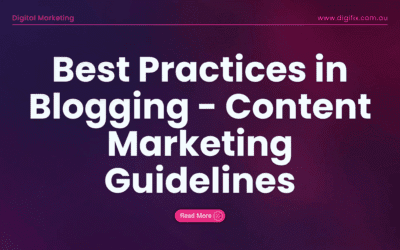

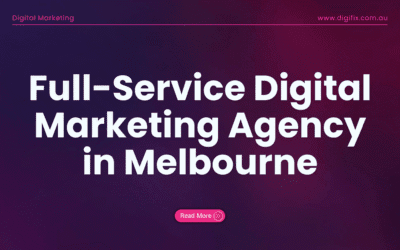
0 Comments